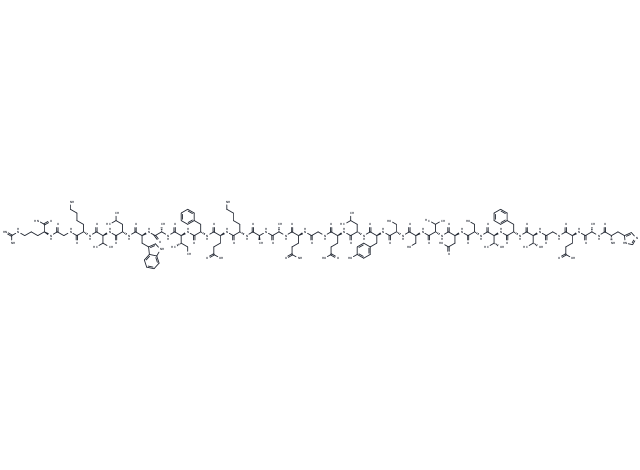Shopping Cart
- Remove All
 Your shopping cart is currently empty
Your shopping cart is currently empty

GLP-1 secretion by human enteroendocrine NCI-H716 cells is augmented in a dose-dependent manner by the addition of CPE.

| Pack Size | Price | Availability | Quantity |
|---|---|---|---|
| 1 mg | $185 | In Stock | |
| 2 mg | $327 | Backorder | |
| 5 mg | $552 | Backorder | |
| 10 mg | $793 | Backorder | |
| 25 mg | $1,220 | Backorder | |
| 50 mg | $1,630 | Backorder | |
| 100 mg | $2,220 | Backorder |
| Description | GLP-1 secretion by human enteroendocrine NCI-H716 cells is augmented in a dose-dependent manner by the addition of CPE. |
| In vitro | METHODS: Human type II lung cells were incubated with GLP-1(7-36)amide (1-1000 nM). 3-isobutyl-1-methylxanthine (0.5 mM) was present during incubation to prevent cAMP hydrolysis. 24 After 1 hour, remove the culture medium and add 1 ml of cold ethanol to lyse the cells. After 1 hour of incubation at 4°C, the wells are scraped and the suspension is centrifuged at 10,000 × g for 10 minutes. The supernatant is removed and evaporated under vacuum. The residues were dissolved in assay buffer and cAMP was measured using a competition binding assay kit (Radiochemistry Center). RESULTS GLP-1(7-36)amide increased cAMP concentration in human type II pneumocytes in a concentration-dependent manner, both in the short and long term. [2] |
| In vivo | METHODS: Tail vein blood samples were collected from male mice each time 5 minutes before glucose infusion. After glucose infusion, GLP-1(7-36)amide [0.3-10 μ mol, intraventricular (i.c.v)] or normal saline (5 μl) was administered. , i.c.v). RESULTS GLP-1(7-36)amide (0.3-10 nmol, i.c.v) dose-dependently reduced the blood glucose AUC0-50 value by 32.6%. [1] METHODS: A 390-minute intravenous infusion of GLP-1-(7-36)amide was studied in 14 healthy volunteers. After 30 minutes, a solid test meal was provided, and gastric emptying was assessed. Blood was drawn for GLP-1 (total and intact), glucose, insulin, C-peptide, and glucagon measurements. RESULTS Administration of GLP-1-(7-36)amide significantly increased total GLP-1 plasma levels. During infusion of GLP-1-(7-36)amide, plasma concentrations of intact GLP-1 increased to 21 +/- 5 pmol/l. GLP-1-(7-36)amide reduced fasting and postprandial glucose concentrations (P < 0.001) and delayed gastric emptying (P < 0.001). GLP-1-(7-36)amide reduces glucagon levels. [3] |
| Alias | MKC 253, Human GLP-1-(7-36)-amide, Glucagon-like Peptide 1 (7-36) amide, GLP-1(7-36)-amide, GLP-1-(7-36)-amide |
| Molecular Weight | 3297.63 |
| Formula | C149H226N40O45 |
| Cas No. | 107444-51-9 |
| Smiles | C([C@@H](C(N[C@H](C(N[C@H](C(N[C@H](C(NCC(N[C@@H](CCCNC(=N)N)C(N)=O)=O)=O)CCCCN)=O)C(C)C)=O)CC(C)C)=O)NC([C@@H](NC([C@@H](NC([C@H](CC1=CC=CC=C1)NC([C@@H](NC([C@@H](NC([C@@H](NC([C@@H](NC([C@@H](NC(CNC([C@@H](NC([C@@H](NC([C@H](CC2=CC=C(O)C=C2)NC([C@@H](NC([C@@H](NC([C@@H](NC([C@@H](NC([C@@H](NC([C@@H](NC([C@H](CC3=CC=CC=C3)NC([C@@H](NC(CNC([C@@H](NC([C@@H](NC([C@H](CC4=CN=CN4)N)=O)C)=O)CCC(O)=O)=O)=O)[C@@H](C)O)=O)=O)[C@@H](C)O)=O)CO)=O)CC(O)=O)=O)C(C)C)=O)CO)=O)CO)=O)=O)CC(C)C)=O)CCC(O)=O)=O)=O)CCC(N)=O)=O)C)=O)C)=O)CCCCN)=O)CCC(O)=O)=O)=O)[C@H](CC)C)=O)C)=O)C=5C=6C(NC5)=CC=CC6 |
| Relative Density. | 1.47 g/cm3 |
| Storage | keep away from moisture | Powder: -20°C for 3 years | In solvent: -80°C for 1 year | Shipping with blue ice. | ||||||||||||||||||||
| Solubility Information | DMSO: 10 mM, Sonication is recommended. | ||||||||||||||||||||
Solution Preparation Table | |||||||||||||||||||||
DMSO
| |||||||||||||||||||||

Copyright © 2015-2025 TargetMol Chemicals Inc. All Rights Reserved.